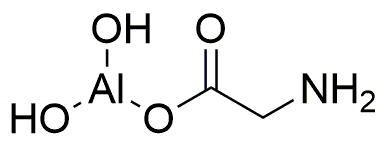Aluminum glycinate is widely utilized in research focused on
- Food Industry: It serves as a food additive, enhancing the nutritional profile of products by providing a source of aluminum in a bioavailable form, which can be beneficial for certain dietary needs.
- Pharmaceuticals: This compound is used in the formulation of medications, particularly as a stabilizer or excipient, improving the solubility and absorption of active ingredients.
- Cosmetics: Aluminum glycinate is incorporated into skincare products for its moisturizing properties, helping to improve skin texture and hydration.
- Agriculture: It is applied in fertilizers to enhance nutrient uptake in plants, promoting healthier growth and increased yields.
- Research Applications: In laboratory settings, it is utilized in studies related to metal ion interactions, providing insights into biochemical processes and potential therapeutic applications.
General Information
Properties
Safety and Regulations
Applications
Aluminum glycinate is widely utilized in research focused on
- Food Industry: It serves as a food additive, enhancing the nutritional profile of products by providing a source of aluminum in a bioavailable form, which can be beneficial for certain dietary needs.
- Pharmaceuticals: This compound is used in the formulation of medications, particularly as a stabilizer or excipient, improving the solubility and absorption of active ingredients.
- Cosmetics: Aluminum glycinate is incorporated into skincare products for its moisturizing properties, helping to improve skin texture and hydration.
- Agriculture: It is applied in fertilizers to enhance nutrient uptake in plants, promoting healthier growth and increased yields.
- Research Applications: In laboratory settings, it is utilized in studies related to metal ion interactions, providing insights into biochemical processes and potential therapeutic applications.
Documents
Safety Data Sheets (SDS)
The SDS provides comprehensive safety information on handling, storage, and disposal of the product.
Product Specification (PS)
The PS provides a comprehensive breakdown of the product’s properties, including chemical composition, physical state, purity, and storage requirements. It also details acceptable quality ranges and the product's intended applications.
Certificates of Analysis (COA)
Search for Certificates of Analysis (COA) by entering the products Lot Number. Lot and Batch Numbers can be found on a product’s label following the words ‘Lot’ or ‘Batch’.
Número de catálogo
Número de lote/lote
Certificates Of Origin (COO)
This COO confirms the country where the product was manufactured, and also details the materials and components used in it and whether it is derived from natural, synthetic, or other specific sources. This certificate may be required for customs, trade, and regulatory compliance.
Número de catálogo
Número de lote/lote
Safety Data Sheets (SDS)
The SDS provides comprehensive safety information on handling, storage, and disposal of the product.
DownloadProduct Specification (PS)
The PS provides a comprehensive breakdown of the product’s properties, including chemical composition, physical state, purity, and storage requirements. It also details acceptable quality ranges and the product's intended applications.
DownloadCertificates of Analysis (COA)
Search for Certificates of Analysis (COA) by entering the products Lot Number. Lot and Batch Numbers can be found on a product’s label following the words ‘Lot’ or ‘Batch’.
Número de catálogo
Número de lote/lote
Certificates Of Origin (COO)
This COO confirms the country where the product was manufactured, and also details the materials and components used in it and whether it is derived from natural, synthetic, or other specific sources. This certificate may be required for customs, trade, and regulatory compliance.

